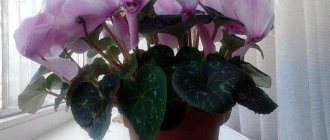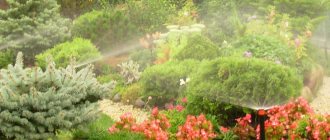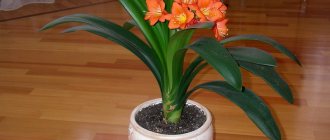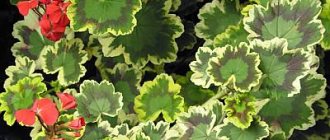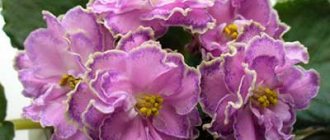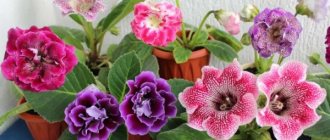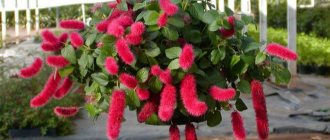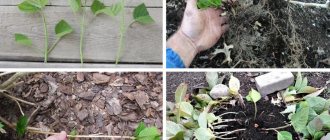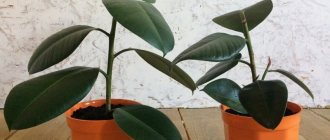Hydrangea (Hydrangea) is a member of the genus of flowering plants in the Hydrangeaceae family. This genus includes approximately 80 species, and is represented by shrubs and small trees. Under natural conditions, this plant is found in South and North America, Japan, China and other countries of South and East Asia. This plant was named after one of the princesses of the Holy Roman Empire. And systematic botanists called it “hydrangea,” which is translated from ancient Greek as “a vessel with water.” This is due to the fact that the plant is very moisture-loving.
Hydrangea appeared in indoor culture in European countries in 1820. Later, it began to be cultivated in open ground. As soon as flower growers and gardeners began to grow hydrangea, experts began breeding. Thanks to them, many varieties and varieties were born. Today, this beautifully flowering plant can be found not only in the garden, but also in a pot on the terrace, veranda or balcony.
Choosing the right hydrangea in the store
You can buy hydrangea at the market, but it is safer to buy it in a store that specializes in selling flowers.
First, the flower in the pot is inspected, starting from the stem. A healthy plant's stem has a rich green color and should be strong and elastic. The leaves should also have a bright green color and be succulent, without any spots or brown formations.
You should not purchase a plant with any deviations in the form of white or yellow spots, with limp leaves or dry fringe along the edges of the leaves. Such a plant will not please your household after purchase, growing at home - it will quickly die. It is important to know how to properly care for hydrangea so that the bush blooms luxuriantly and turns green.
We carefully examine the balls of inflorescences of a flowering plant. The cap has a dense covering of bright buds. If a flower lacks nutrients, the inflorescences are pale in color and fall off when touched.
Note!
When purchasing any flower, it must have a healthy appearance, bright and rich color.
Why replant hydrangea to a new place or in another pot?
In order for hydrangea to bloom magnificently and abundantly, it requires adequate care. Sometimes a crop has to be transplanted to a new location. Most often this is done in the following situations:
- The flower does not suit the area in which it grows. In this case, growth retardation and disease development are observed.
- The wrong place was chosen for the plant, and it bothers people.
- The soil in which hydrangea grows has become very depleted. The culture can grow in one place for 10 years. However, experienced gardeners replant hydrangea every 5 years.
- The indoor hydrangea has grown greatly, and the pot has become too small for it.
In order for hydrangea to bloom magnificently, it must be replanted correctly.
Novice flower growers are interested in when it is possible to transplant hydrangea from one place to another. The success of the procedure directly depends on the correct timing of the procedure.
Transplantation and care after purchase
Any flower, including hydrangea, cannot be replanted immediately after purchase. It must adapt to new conditions, growing in a pot on the windowsill, this will take from 2 to 4 weeks. Subsequently, one should not forget about regular transplants; at home, they should be carried out at intervals of 3 years. Only proper care of hydrangea will give abundant flowering and a lush crown of the bush.
Hydrangea is able to please its owner with chic and lush flowering, provided that the pot for it is voluminous, because the roots love space and grow in breadth. Therefore, you need to ensure that the size of the plant matches the volume of the container.
May be interesting Scindapsus: growing, care and propagation at home Why do the roots of the phalaenopsis orchid rot and what to do Flowers in the house - to joy or to loss? Signs and foreign
When replanting, the pot should not be much larger than the previous one. You can buy ready-made soil “for hydrangeas,” or you can prepare the mixture yourself. To do this, take sand, leaf and turf soil in a ratio of 1:3:3.
The pot for hydrangea is not deep, but wide, since its roots grow wide. If you take a container that is too large, the plant may not bloom for a long time.
To preserve the root system, the bush is simply transferred to another pot when transplanted into another pot. This protects the flower from stress.
A thick layer of drainage is poured onto the bottom of the pot. On him –
a small layer of prepared earthen mixture. Then we dump the hydrangea out of the pot along with the lump, which is placed in a new container. All empty spaces in the pot are filled with earthen mixture, but the neck of the plant should not be buried.
Immediately after transplanting, the hydrangea is watered abundantly so that the moisture does not evaporate quickly, and the soil surface is mulched with peat.
Brief description of cultivation
- Bloom. It starts in April and ends in November.
- Illumination. The light should be bright, but at the same time diffused. To do this, it is enough to place the bush near a south-facing window (at a distance of 200–300 cm).
- Temperature conditions. During the growing season - about 20 degrees, and during the dormant period - from 7 to 10 degrees.
- Watering. During the summer months, the bushes need plenty of frequent watering. In spring and autumn, water more rarely and moderately. During the dormant period, the soil is moistened rarely and sparingly.
- Humidity. Requires high air humidity. On hot days, the bush should be moistened as often as possible with a spray bottle.
- Fertilizer. Feeding is carried out during the period February–October. To do this, use a mineral complex for flowering plants (heathers, azaleas and rhododendrons), and apply fertilizer to the soil twice a month. In winter, the plant does not need fertilizer.
- Rest period. Observed in December and January.
- Transfer. It is carried out only for indoor hydrangea every year, and its life expectancy is from 3 to 4 years.
- Trimming. In the autumn, when the bushes have faded, weakened stems must be cut off, and powerful shoots must be shortened by ½ part of the length. With the onset of spring, cut out any weak stems that have become very elongated during the dormant period.
- Reproduction. By cuttings, dividing the bush and seed method.
- Pests. Spider mites and aphids.
- Diseases. Downy mildew and gray mold.
Caring for hydrangea at home
Lighting
Hydrangea loves plenty of light, but direct sunlight can damage the delicate leaves and leave burns on them. With the right location, the bush will bloom long and profusely, delighting you with its bright fluffy balls. To do this, the hydrangea pot should be placed in a bright place where the sun's rays will not hit the plant. Ideally, this place is 3 meters from the window.
Temperature
Hydrangea is quite picky with temperature. Ideal conditions for it would be a temperature in the range of 18 –
23 °C.
Drafts for hydrangea are not only undesirable, they are detrimental to the flower, it can die. In order for the bush to bloom abundantly in summer, in winter it should be allowed to rest and gain strength. To do this, the plant is placed in a room with a temperature of about 10 °C.
Hydrangea propagation
When studying how indoor hydrangea reproduces, do not forget about varietal characteristics. There are varieties that reproduce in only one way. However, the vast majority of subspecies can be propagated:
- Dividing the root system. The procedure is performed at the time of transplantation. The cuttings must have a growing point and a powerful root. To successfully complete the work, it is necessary to shorten the roots and shoots. Complete rooting of the cuttings occurs by autumn, and the next year the plant blooms. When dividing the bush, all the properties of the mother plant are preserved.
- Seeds. This method is performed in winter. Seeds are sown in February in a composition of turf, garden soil and humus, taken in equal quantities. It is necessary to sow the hydrangea superficially and cover the crops with plastic wrap. The greenhouses are ventilated and sprayed daily. At the first appearance of seedlings, the crops open and move to a bright place. As soon as the hydrangea forms 2-3 leaves, it is picked into separate pots with a diameter of 5-7 cm.
- By cuttings. To implement the technique, you should cut off root cuttings 8 cm long with 3 internodes in February. The leaves are shortened by 2/3, and the bottom is cut off completely. The cut sites are treated with special preparations to form a root system and planted in a substrate of sand and peat. Planted specimens are kept at a temperature of 20 degrees in the brightest place. The rooting period lasts 3-4 weeks.
Indoor hydrangea, planted and cared for at home correctly, practically does not get sick and tolerates all manipulations well. It would be a good idea to spray young plants once a month with a growth stimulator.
Features of transplanting indoor hydrangea
For annual and abundant flowering, it is necessary to ensure proper care of the hydrangea after purchase. The bush at home should be replanted every year in a different pot. To prepare the soil for replanting, take 1 part sand, 3 parts turf and 3 parts leaf soil. Mix everything, distributing all components evenly.
Cover the bottom of the pot with a thick layer of expanded clay as drainage. Sprinkle the expanded clay with a layer of the prepared mixture, slightly pressing it down. Carefully remove the prepared flower from the pot along with the earthen lump and place it in a new pot. We fill the trunk with fresh earthen mixture, leaving the neck of the plant uncovered.
Important!
After transplanting, the flower must be watered and the surface of the soil covered with mulch, then the moisture will not evaporate quickly.
Content Features
Like any plant, hydrangea needs care that will provide it with comfortable conditions for growth and flowering. Depending on the season of the year, the flower needs feeding, a certain regime of watering and lighting.
The soil
Depending on the shade that is preferred, a certain acidity of the soil should be adhered to.
White and cream flowers love neutral soil, red and pink flowers can only grow in alkaline soils. But the blue and blue shades of hydrangea will retain their color exclusively on soil with high acidity. To make the soil yourself, you will need to take two parts of turf soil, 1 part of sheet soil, half of a part of peat and one part of sand.
Landing
Hydrangea in a pot can grow for up to 4 years, but it must be replanted annually to achieve lush and abundant flowering. The root system of the flower is located horizontally, which is why preference should be given to low and wide pots.
Hydrangea is replanted using the transshipment method, due to which the roots are subject to the least trauma and the plant experiences less stress. Typically, planting and replanting indoor flowers is done in the fall, after the bush has dropped its leaves.
Fertilizers
Since the color of a plant depends on the properties of the soil, there are several types of fertilizers that ensure the brightness of the inflorescences. The earth is oxidized with sawdust, peat or pine needles. An alkaline environment is created by mixing lime, ash or chalk into the soil. You can also purchase industrial fertilizers in special stores that regulate color strength.
Temperature, light and humidity
During periods of growth and flowering, the plant should be kept in rooms with good lighting and a temperature of 18-22 degrees. The flower loves moist soil and therefore requires watering 2-3 times a week during active periods of the year. Hydrangea is best grown near large windows that face west or east. Direct sunlight can cause serious burns on the flower.
During the dormant period, the indoor bush needs to be watered once every 2-3 weeks. At home, in winter, a flower can be taken to the balcony to achieve artificial winter conditions. When the first buds swell, the plant must be returned to a warm, well-lit room and the frequency of watering increased.
Throughout the year, you need to maintain high humidity in the room where the flower grows. The first sign of low humidity in the interior is the drying of the tips of the leaves of the plant.
The simplest option for locally increasing humidity in a room is a container of water that stands near the potted composition. Also, the leaves will look healthier with regular spraying.
Ventilation
Unlike a garden plant, indoor hydrangea does not like drafts and open windows. The flower feels great in open areas and closed terraces. When drafts occur, the plant may shed its leaves, stop blooming, or die completely.
Watering and fertilizing hydrangeas
Hydrangea loves abundant watering, but to prevent the root system from rotting, irrigation should be carried out when the top layer of the substrate dries. When flowering and during the period of active growth, hydrangea needs abundant and frequent watering.
During the dormant period, the intensity of watering is reduced, and in winter, the earthen ball should not dry out, but abundant watering is not needed.
In the spring, as soon as green leaves begin to appear on the branches of the plant, watering is resumed.
Water for irrigation should be soft and at room temperature. You cannot water the plant with tap water; it must settle.
Hydrangea is fertilized only in summer with mineral fertilizers twice a week. The irrigation solution includes potassium sulfate 30 g, superphosphate 40 g, ammonium nitrate 30 g per bucket of water.
On a note!
Feeding is done all summer, until mid-August. This is the time of flower bud formation. All weak branches are removed, as well as root shoots.
What to do with potted hydrangea in spring?
Around the end of March, the overwintered hydrangea should be taken out of the basement, shed with warm water and fed. If necessary, the bush can be transplanted into a larger pot, and after watering, be sure to mulch it to retard the evaporation of moisture. Before “moving” outside, the pot needs to find a bright place in the house.
For feeding, it is better to use a special long-acting complex fertilizer for hydrangeas (in granules). Coniferous litter or pine bark is well suited as mulch - rotting, it additionally acidifies the soil, and hydrangea loves this.
You can take hydrangea into the garden no earlier than the end of April, or even in May, but at first take it into the house at night or cover it with agrofibre so that the bush does not suffer from return frosts.
Particular attention should be paid to the location of the hydrangea in the garden, because it does not like too bright lighting, which will cause the flowers to fade. As long as there are no buds, the east side is best. And during flowering, it is worthwhile to completely remove the bush under a canopy so that the sun hits it only in the evening.
Trimming
To form a beautiful bush shape, pruning is necessary. A pruner or sharp knife is suitable for this.
Cuts should be made even and smooth. During pruning, it is necessary to remove all dry, diseased, damaged branches and leaves. To form a lush crown, the top is trimmed evenly and evenly. It is advisable to shorten the shoots in spring and autumn. During the flowering period, pruning is not recommended. It can be renewed when the first flowering branches appear. They should be removed immediately so that they do not begin to rot.
When is it better to replant: the pros and cons of different replanting dates
Transplanting rhododendron from one place to another
Experienced gardeners advise moving the crop to a new place at different times - in spring or autumn. Sometimes a plant needs urgent replanting. It is performed in the summer.
in spring
In spring, hydrangea is replanted even before the bush begins to awaken and buds begin to bloom. It is important that the snow melts completely. The disadvantage of transplanting hydrangea to another place in the spring is that the plant spends a lot of energy restoring its roots. This negatively affects flowering.
In summer in June or July - transplant flowering hydrangea
Many gardeners are interested in whether it is possible to replant garden hydrangea in June or July. This can only be done in extreme cases. At the same time, transplanting a crop during the flowering period is very dangerous. It can lead to a lack of flowering for several years or the complete death of the bush.
in autumn
Autumn is considered the ideal time to plant a plant. Specific timing depends on regional specifics. In the middle zone and in the Moscow region, tree and paniculate hydrangea can be planted in September. Depending on the weather, the procedure is carried out at the beginning or end of the month.
It is best to transplant in the autumn season
In the Leningrad region, bushes can be planted in early or mid-September. This region is characterized by a damp climate, which will benefit the plant. This crop needs sufficient moisture.
Siberia and the Urals are characterized by a short autumn. Therefore, it is better not to move the plant to a new place in the fall. Sometimes it is allowed to be transplanted at the end of August. For the winter, the bushes must be insulated with spruce branches, leaves or lutrasil.
Important! In order for the bush to take root normally, it must have fully matured branches and trunk. Good root development is of great importance.
The southern regions are characterized by warm autumns and mild winters. Therefore, the crop can be replanted in October. Even large-leaved hydrangea can withstand autumn replanting. Most often, the procedure is carried out at the beginning or end of September. The indoor bush should be replanted in April.
How to properly replant garden hydrangea
There is nothing difficult about how to transplant a hydrangea. First you need to choose the right place for planting and suitable soil. This will ensure easy adaptation of the bush.
Selecting a location
When to transplant lilies from one place to another
When choosing a site, it is important to consider that the plant should receive a lot of light in the morning and evening. Moreover, most of the time it should be in partial shade. Full protection from the wind is of no small importance. Otherwise the bushes may break.
Important! It is not recommended to plant hydrangea under trees. Otherwise, the plants will need moisture and begin to compete.
Preparing the pit and soil
To grow hydrangeas, you should use loose and fertile soil. It should have a slightly acidic reaction - 5-6.2 pH. You need to prepare the hole for planting in advance - at least 2 weeks in advance.
The dimensions of the recess for planting depend on the volume of seedlings. Most often they are made 50-60 cm wide. When planting several bushes, it is worth maintaining an interval of 1-1.5 m, since they are characterized by rapid growth.
Hydrangea requires slightly acidic soil
Preparing the plant: with a clod of earth or dividing the bush
To facilitate the process of digging up an adult bush, it needs to be well watered. Thanks to this, the lump of earth will hold tightly and will not fall apart during transplantation. Then you need to carefully dig up the plant from all sides. It is worth retreating 20-25 cm from the center.
After digging, you can plant the plant in a new place. This can be done with a lump of soil. If you plan to divide the bush, the root system of the plant must be cleared of excess soil. Then the plant is divided into several fragments. Each of them must have renewal buds. After this, each bush must be planted on a hill and the root system should be straightened.
Direct transplant
To plant hydrangeas you need to do the following:
- Place the plant in the center of the hole.
- Sprinkle with soil up to the root collar. It should be flush with the soil surface.
- Lightly compact the soil.
- Water the bush generously.
- If the soil settles, it needs to be replenished.
Important! Finally, the bed needs to be covered with a mulching layer 5-8 cm thick. For this, you can use pine needles or high-moor peat.
To transplant a crop, you need to follow a number of rules
